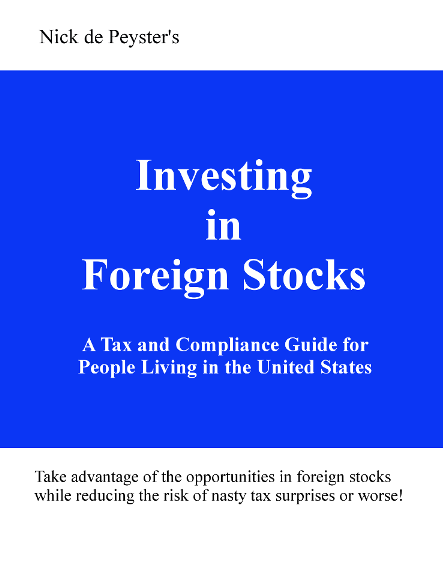In their search for strong investment returns, many investors have increasingly looked abroad to international markets.
International diversification makes sense from several perspectives. For instance, we wrote here about a paper that argued that some decisions to allocate to U.S. equities are due to survivorship bias. Our friend Meb Faber had an interesting post earlier this year arguing that foreign developed and emerging markets have a lower CAPE ratios than the U.S., and thus have higher expected returns than the U.S. We also reviewed a book about emerging market investing. There are certainly reasonable arguments for why investors would want to consider international markets.
With international investing comes some additional complexity on the tax and compliance front. Not an exciting topic, but an important one. Fortunately, figuring out the myriad of rules and regulations associated with international investing is a bit easier thanks to a new reference book by Nick de Peyster.
Nick’s new book is called, “Investing in Foreign Stocks: a Tax and Compliance Guide for People Living in the United States.”
 Nick is an IAR at Genesis Wealth Advisors, which is an RIA that develops retirement savings portfolios, and wealth management strategies for individuals and families. In his capacity as an advisor, Nick has spent quite a bit of time over the years investigating the intricacies of investing internationally in individual stocks through foreign exchanges. Nick’s book is a solid reference and resource for anyone looking to learn more about what’s involved.
Nick is an IAR at Genesis Wealth Advisors, which is an RIA that develops retirement savings portfolios, and wealth management strategies for individuals and families. In his capacity as an advisor, Nick has spent quite a bit of time over the years investigating the intricacies of investing internationally in individual stocks through foreign exchanges. Nick’s book is a solid reference and resource for anyone looking to learn more about what’s involved.
Nick points out that in the U.S. there are 3,700 stocks with > $50mm market cap, whereas internationally, there are 14,000 stocks with > $50mm market cap. Thus, there are vastly more stocks to choose from. Additionally, international stocks are underfollowed relative to markets in the U.S., giving rise to the greater potential for misvaluation.
While tax and compliance are not typically a problem in developed markets like Japan, Canada and Australia, in smaller markets there are a variety of quirks that can add costs and complexity to any strategy. It is the investors job to assess whether the higher return potential can offset the added costs and complexity involved.
The book is divided into two sections: 1) issues to consider before investing internationally, and 2) a country by country analysis covering dozens of countries.
In the first part of the book, Nick covers a range of issues: Tax considerations, Trust and retirement account issues, currency considerations, legal issues, and much more. Most of the complexity involves taxation, including double taxation, tax treaties, PFIC, and treatment of tax credits. But there are other issues to consider, including disclosure requirements, shareholder restrictions, and capital controls. Nick’s experience shines through across these areas. While you may not get the definitive answer on whether you personally, or your IRA, should pay a legal bill in Burundi, you will get enough background to ask the right questions.
The second part of the book covers information specific to a number of countries. This section includes an overview of tax treaties, how trusts and IRAs are treated, regulations, securities law, and a discussion of relevant government agencies that administer the laws. Nick also has a number of helpful suggested local resources (accountants, securities and estate lawyers, etc.) who can assist on the ground in the various countries.
It is important to reiterate that this is a reference book. It is not intended to be an exhaustive treatment of this complex subject, and is not an easy read. This brings me to a piece of constructive criticism we would offer: The book is not organized in a way that is especially “friendly” to the reader. It is more targeted to the province of CPAs, lawyers, and sophisticated advisors. But if you have specific questions regarding a cross-border investment strategy you are considering, you are likely to find at least some discussion of it in the book that will be helpful. In sum, this is a nice resource to have on your bookshelf– especially if you are investing in international markets and live in the United States.
About the Author: David Foulke
—
Important Disclosures
For informational and educational purposes only and should not be construed as specific investment, accounting, legal, or tax advice. Certain information is deemed to be reliable, but its accuracy and completeness cannot be guaranteed. Third party information may become outdated or otherwise superseded without notice. Neither the Securities and Exchange Commission (SEC) nor any other federal or state agency has approved, determined the accuracy, or confirmed the adequacy of this article.
The views and opinions expressed herein are those of the author and do not necessarily reflect the views of Alpha Architect, its affiliates or its employees. Our full disclosures are available here. Definitions of common statistics used in our analysis are available here (towards the bottom).
Join thousands of other readers and subscribe to our blog.

